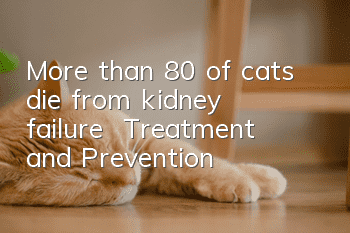More than 80% of cats die from kidney failure | Treatment and Prevention

Cats only have two kidneys, and each kidney has a ureter connected to the bladder. The combined function of both kidneys is usually higher than what the body needs to function properly, so their kidney function is very good.
It is precisely because of such pampering that many cats do not like to drink water, which keeps their kidneys in a state of overwork. When kidney function cannot meet the needs of the body, a phenomenon medically known as renal failure occurs. It is no wonder that kidney disease is the number one killer of cats.
1. Classification of renal failure
Acute renal failure refers to the sudden loss of the kidney's filtration function, resulting in the accumulation of nitrogenous waste, loss of water, electrolyte and acid balance. Recovery is usually possible if diagnosed and treated quickly.
Chronic renal failure is a gradual deterioration of the function of the kidney itself, which usually takes several months to a year. When more than 75% of the nephron cells in the kidney are damaged, polyuria and severe thirst will occur. The average age of onset is around seven years old, and as we get older, the proportion becomes higher and higher.
1. Chronic renal failure
The first symptom is polyuria and severe thirst. When the condition worsens, other symptoms include weight loss, coat color change, anorexia, vomiting, bad breath, gum infection, and oral ulcers. Eventually, the cat cannot retain water and becomes dehydrated, leading to weakness and Collapse, shock, and death. Death is usually caused by heart failure due to increased potassium flow in the blood. Chronic renal failure is usually a disease of older cats, but is not absolute.
[Causes include]
(a) Infection of the kidneys or other parts of the body
(b) Problems with the body’s immune system
(c) Hereditary kidney defects
(d) Kidneys affected by toxins
(e) Decreased kidney function due to normal aging
2. Acute renal failure
It occurs quickly and often produces obvious symptoms, such as anuria, vomiting, weakness, collapse, and death.
[Causes include]
(a) Drug poisoning
(b) Any disease causing dehydration or loss of fluids
(c) Sudden worsening of chronic renal failure
(d) Obstruction of urination, such as urethral obstruction
(e) Shock or heart failure
★Tips for self-diagnosis
(a) Overall condition: Body appearance, hair generally good, skinLoss of elasticity (dehydration), hypothermia, fever, shortness of breath, slow heartbeat, sudden loss of appetite, listlessness, movement disorders, and epilepsy.
(b) Gastrointestinal symptoms: bad breath, oral ulcers, glossitis and even tongue ulcers, vomiting (sometimes containing blood).
(c) Respiratory symptoms: A strong smell of ammonia appears in the breath.
(d) Urinary tract symptoms: oliguria, anuria or polyuria.
- A cat will die if it urinates for a few days
- Should you deworm yourself or go to a pet store?
- Are cat teasers harmful to cats?
- What should I do if my cat suffers from chronic gingivitis?
- Cat's nails are cracked with a thin layer
- Cats go crazy after eating mutton
- What does cat moss on a cat’s chin look like?
- Can cats reproduce after abdominal transmission is cured?
- What exactly is the sterilization shot for female cats?
- Can I still eat unopened cat food if it has expired?



